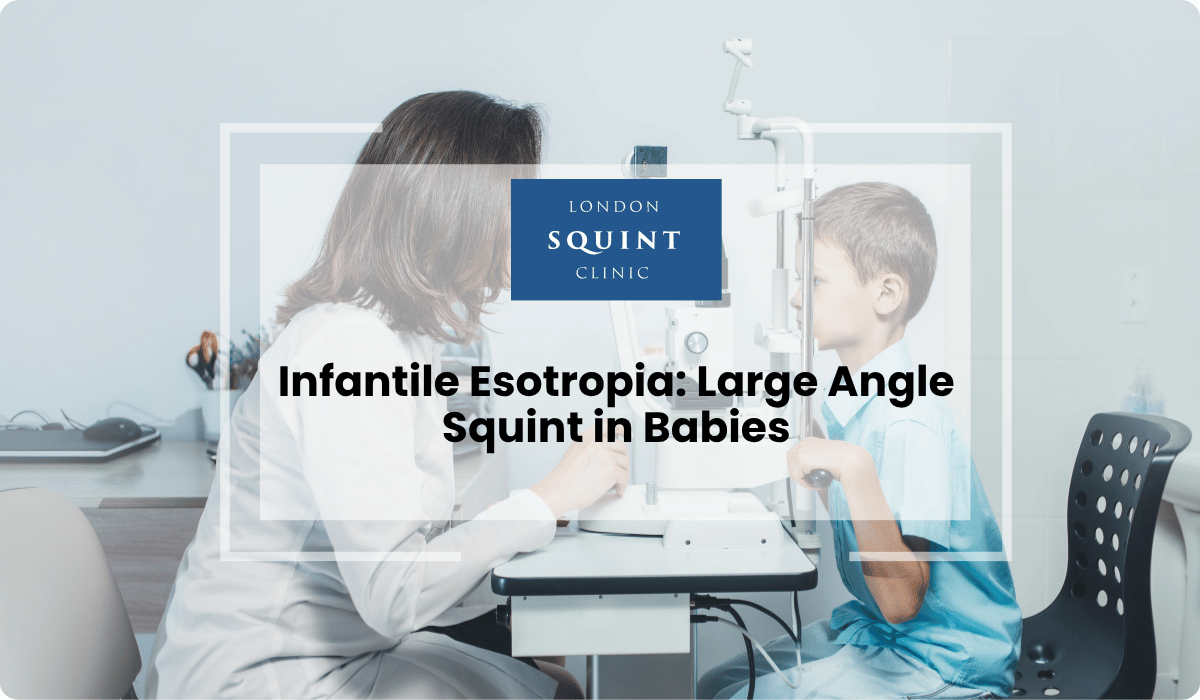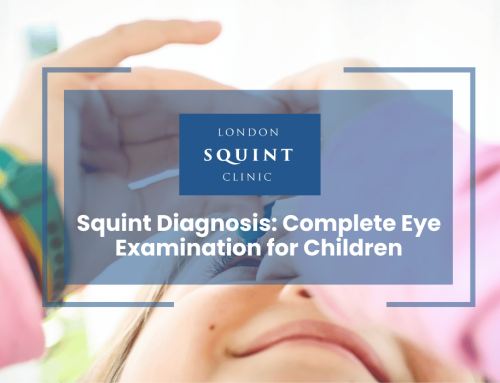Infantile Esotropia: Large Angle Squint in Babies
Infantile Esotropia
- Infantile esotropia is a large-angle inward eye turn that typically develops within the first six months of life and requires specialist assessment.
- Early diagnosis is crucial—look for consistent inward eye turning, large angle deviation, and unusual head positions in your baby.
- The condition stems primarily from neurological development issues rather than eye muscle weakness, with genetic factors and prematurity increasing risk.
- Comprehensive diagnosis includes visual acuity assessment, alignment measurements, and ruling out other conditions that mimic infantile esotropia.
- Surgical intervention is typically necessary and most effective when performed between 6-12 months of age during the critical period of visual development.
- Early intervention (before 24 months) offers the best chance for developing binocular vision and depth perception.
- Long-term outcomes vary, with 60-80% achieving good alignment with a single surgery, though some children require additional procedures as they grow.
- Consistent follow-up throughout childhood is essential to monitor alignment, visual development, and address any recurrence promptly.
Table of Contents
- Understanding Infantile Esotropia: Causes and Characteristics
- How to Identify Large Angle Squint in Your Baby
- Why Do Some Babies Develop Crossed Eyes?
- Diagnosis and Assessment of Early Onset Esotropia
- Treatment Options for Infantile Esotropia
- Timing of Intervention: When Surgery Becomes Necessary
- Long-term Outcomes and Visual Development
- Supporting Your Child Through Treatment
Understanding Infantile Esotropia: Causes and Characteristics
Infantile esotropia, also known as congenital esotropia, is a specific type of strabismus (squint) that typically develops within the first six months of life. This condition is characterised by a large inward turning of one or both eyes, creating the appearance of crossed eyes. Unlike other forms of strabismus that may come and go, infantile esotropia typically presents as a constant, large-angle deviation that remains relatively stable throughout infancy.
The hallmark characteristics of infantile esotropia include:
- Early onset, typically before 6 months of age
- Large angle of inward deviation (usually 30-80 prism dioptres)
- Consistent presence of the squint
- Equal deviation in all directions of gaze
- Often accompanied by cross-fixation (using the right eye to look left and the left eye to look right)
- Potential for associated vertical deviations or dissociated vertical deviation (DVD)
Unlike accommodative esotropia, which develops later and is related to focusing efforts, infantile esotropia is not typically triggered by focusing on near objects. The exact cause remains somewhat elusive, but current understanding points to abnormal development of binocular vision centres in the brain rather than a primary muscle problem. This neurological basis explains why early intervention is crucial for developing normal binocular vision and depth perception.
How to Identify Large Angle Squint in Your Baby
Recognising infantile esotropia in your baby is crucial for early intervention. While occasional eye misalignment can be normal in the first few months as visual coordination develops, persistent inward turning of the eyes warrants attention. Here are key signs to watch for:
- Consistent eye turning: One or both eyes consistently turn inward, particularly noticeable when your baby is looking straight ahead
- Large angle deviation: The misalignment is often quite noticeable, with a significant portion of the iris (coloured part of the eye) appearing to disappear toward the nose
- Persistence: The squint remains present throughout the day and doesn’t come and go with fatigue or illness
- Head tilting or turning: Your baby may adopt unusual head positions to compensate for the misalignment
- Cross-fixation: You may notice your baby using the right eye to look at objects on the left side and the left eye for objects on the right
A simple home assessment involves taking clear, well-lit photographs of your baby looking directly at the camera. In these images, the light reflection (corneal reflex) should appear symmetrically positioned in both eyes. Asymmetry in these reflections can indicate eye misalignment. However, professional evaluation is essential, as understanding squint in children requires specialised expertise to differentiate between normal developmental variations and true infantile esotropia.
Why Do Some Babies Develop Crossed Eyes?
The development of infantile esotropia involves complex neurological and visual system factors. While the precise cause remains incompletely understood, several contributing factors have been identified:
- Neurological development: The brain centres responsible for coordinating eye movements and binocular vision may develop abnormally in some infants
- Genetic predisposition: There appears to be a hereditary component, with a higher incidence in families with a history of strabismus
- Prematurity: Babies born prematurely have a higher risk of developing infantile esotropia
- Neurological conditions: Certain neurological disorders like cerebral palsy can increase the likelihood of early-onset squint
- Refractive errors: While less common in infantile esotropia (compared to accommodative esotropia), significant uncorrected hyperopia (long-sightedness) can contribute to eye misalignment
It’s important to note that infantile esotropia differs from pseudoesotropia, a common condition where the appearance of crossed eyes results from facial features such as a wide nasal bridge or prominent epicanthal folds (skin folds in the inner corner of the eye). In pseudoesotropia, the eyes are actually properly aligned despite appearing crossed. A comprehensive ophthalmological examination can differentiate between true infantile esotropia and pseudoesotropia.
Understanding that infantile esotropia stems primarily from neurological development rather than eye muscle weakness helps explain why early intervention is crucial—it provides the developing brain with the opportunity to establish proper binocular connections during the critical period of visual development.
Diagnosis and Assessment of Early Onset Esotropia
Accurate diagnosis of infantile esotropia requires comprehensive assessment by a paediatric ophthalmologist or strabismus specialist. The diagnostic process typically involves several specialised evaluations:
- Visual acuity assessment: Age-appropriate methods are used to evaluate how well each eye sees, which may include preferential looking tests or visual evoked potentials in pre-verbal infants
- Ocular alignment measurements: The precise angle of misalignment is measured using prism bars and specialised light reflexes (Hirschberg test or Krimsky test)
- Ocular motility examination: Assessment of how well the eyes move in different directions to rule out muscle restrictions or palsies
- Cycloplegic refraction: Special eye drops temporarily paralyse the focusing muscles to accurately measure any refractive errors (long-sightedness, short-sightedness, or astigmatism)
- Fundus examination: Detailed examination of the retina and optic nerve to rule out any structural abnormalities
- Neurological assessment: Evaluation of overall development and neurological function, particularly if there are concerns beyond the eye misalignment
Differential diagnosis is crucial, as several conditions can mimic infantile esotropia. These include accommodative esotropia (related to focusing efforts), Duane syndrome (a congenital eye movement disorder), sixth nerve palsy (affecting the lateral rectus muscle), and pseudoesotropia. The pattern of eye movements, consistency of the deviation, and age of onset help distinguish infantile esotropia from these other conditions.
Early diagnosis—ideally before 6 months of age—provides the best opportunity for successful intervention during the critical period of visual development, when the brain remains highly plastic and adaptable.
Treatment Options for Infantile Esotropia
Managing infantile esotropia requires a tailored approach based on the specific characteristics of each case. Treatment strategies focus on aligning the eyes and promoting binocular vision development. The main treatment options include:
- Observation: In very young infants (under 3-4 months), brief periods of observation may be recommended as some cases of apparent esotropia can resolve naturally as visual development progresses
- Optical correction: While infantile esotropia is not primarily caused by refractive errors, any significant hyperopia (long-sightedness) should be corrected with glasses to ensure optimal visual development
- Patching therapy: If amblyopia (lazy eye) has developed, patching the stronger eye for prescribed periods encourages visual development in the weaker eye
- Botulinum toxin (Botox) injections: Sometimes used as a temporary measure or diagnostic tool, Botox weakens the overactive medial rectus muscles, potentially allowing for improved alignment
- Surgical intervention: The mainstay of treatment for infantile esotropia involves surgical realignment of the eyes, typically through recession (weakening) of the medial rectus muscles and/or resection (strengthening) of the lateral rectus muscles
Non-surgical approaches alone are generally insufficient for the large-angle deviations characteristic of infantile esotropia. However, they play important complementary roles in the comprehensive management plan. For instance, addressing any refractive errors with glasses and treating amblyopia with patching optimises visual function in each eye before surgical intervention.
Post-treatment monitoring is essential regardless of the approach taken. Regular follow-up examinations assess alignment stability, visual acuity development, and the potential emergence of binocular vision. Some children may require additional interventions or adjustments to their treatment plan as they grow.
Timing of Intervention: When Surgery Becomes Necessary
The timing of surgical intervention for infantile esotropia remains a subject of ongoing research and clinical debate. However, substantial evidence supports early intervention during the critical period of binocular vision development. Current practice generally recommends:
- Early surgical intervention: Most specialists advocate for surgery between 6-12 months of age once the diagnosis is confirmed and the deviation is stable
- Critical period considerations: Surgery performed before 24 months of age offers the best opportunity for developing some degree of binocular vision and stereopsis (depth perception)
- Stability requirements: The angle of deviation should be stable for at least 2-3 months before proceeding with surgery
- Pre-surgical optimisation: Any significant refractive errors should be corrected and amblyopia addressed before surgical intervention
The rationale for early intervention stems from our understanding of visual development. The brain’s visual pathways demonstrate remarkable plasticity in the first years of life, allowing for the establishment of binocular connections when the eyes are properly aligned. This critical period begins to close progressively after age 2, with diminishing potential for developing normal binocular vision thereafter.
Research indicates that children who undergo successful alignment before 24 months of age have significantly better chances of developing some degree of binocular function compared to those with later interventions. However, even with delayed surgery, benefits including improved cosmetic appearance, expanded visual field, and elimination of abnormal head postures can still be achieved.
The decision regarding surgical timing should be individualised, considering factors such as the stability of the deviation, presence of amblyopia, overall health status, and family preferences after thorough discussion of the risks and benefits.
Long-term Outcomes and Visual Development
The long-term outcomes for children with infantile esotropia depend on several factors, including the timing of intervention, the quality of alignment achieved, and individual variations in visual system development. Understanding realistic expectations helps families navigate the treatment journey:
- Alignment outcomes: Approximately 60-80% of children achieve satisfactory alignment with a single surgery, while others may require additional procedures to maintain alignment as they grow
- Binocular vision development: Children who undergo successful early alignment (before 24 months) have approximately a 25-40% chance of developing some degree of stereopsis (depth perception), though it is typically not as refined as in children without strabismus
- Visual acuity: With appropriate management of any associated amblyopia, most children develop good visual acuity in each eye individually
- Recurrence risk: Approximately 20-30% of children may experience some recurrence of esotropia or development of consecutive exotropia (outward turning) over time, potentially requiring additional intervention
- Associated conditions: Some children with infantile esotropia develop other eye movement abnormalities, including dissociated vertical deviation (DVD) or inferior oblique overaction, which may require separate management
Long-term follow-up is essential throughout childhood and adolescence. Regular monitoring allows for timely detection and management of any recurrence, development of associated conditions, or changes in refractive status. The frequency of follow-up typically decreases as stability is demonstrated, but annual examinations are generally recommended until visual maturity is reached in the late teenage years.
While perfect binocular vision is not always achievable, successful management significantly improves functional and cosmetic outcomes. Many children with well-managed infantile esotropia go on to participate fully in all activities, including those requiring depth perception, by developing compensatory visual strategies.
Supporting Your Child Through Treatment
Parents play a crucial role in the successful management of infantile esotropia. Supporting your child through diagnosis and treatment involves several important aspects:
- Education and understanding: Learn about your child’s condition to make informed decisions and effectively communicate with healthcare providers
- Consistent follow-up: Maintain the recommended schedule of appointments to monitor progress and address any emerging issues promptly
- Compliance with non-surgical treatments: If glasses or patching are prescribed, ensure consistent use according to the specialist’s recommendations
- Pre-surgical preparation: For children undergoing surgery, age-appropriate preparation helps reduce anxiety; hospital child life specialists can provide valuable guidance
- Post-surgical care: Follow all post-operative instructions carefully, including medication administration and activity restrictions
- Emotional support: Acknowledge and address any emotional aspects for both your child and family, particularly regarding appearance concerns in older children
Creating a supportive environment at home and in educational settings is important. For school-aged children, communicating with teachers about your child’s visual condition ensures appropriate classroom accommodations if needed. Books and stories featuring characters with glasses or eye patches can help normalise the experience for younger children.
Parent support groups, both online and in-person, provide valuable emotional support and practical advice from families with similar experiences. Your ophthalmologist can often recommend appropriate resources.
Remember that while the treatment journey may seem daunting, most children adapt remarkably well. With appropriate intervention and support, children with infantile esotropia typically develop good visual function and positive self-image, achieving their full potential in academic, social, and recreational pursuits.
Frequently Asked Questions
Will my baby outgrow infantile esotropia?
Infantile esotropia typically does not resolve without intervention. Unlike occasional eye crossing in newborns (which can be normal until 3-4 months), true infantile esotropia involves a large, constant eye deviation that requires medical treatment. Early evaluation by a pediatric ophthalmologist is essential to distinguish between normal developmental variations and true esotropia requiring intervention.
At what age should infantile esotropia be treated?
Surgical treatment for infantile esotropia is typically recommended between 6-12 months of age once the diagnosis is confirmed and the deviation is stable. Research shows that alignment before 24 months offers the best opportunity for developing binocular vision and depth perception, as this falls within the critical period of visual development when the brain remains highly adaptable.
How successful is surgery for infantile esotropia?
Approximately 60-80% of children achieve satisfactory alignment with a single surgery. About 20-30% may require additional procedures as they grow. While perfect binocular vision is not always achievable, children who undergo successful early alignment have a 25-40% chance of developing some degree of depth perception. Most children develop good visual acuity in each eye with appropriate management.
Can glasses correct infantile esotropia?
Glasses alone are typically insufficient to correct infantile esotropia, which usually involves large-angle deviations. Unlike accommodative esotropia (which develops later and responds well to glasses), infantile esotropia primarily stems from neurological development rather than focusing issues. However, if significant hyperopia (long-sightedness) is present, glasses may be prescribed as part of the comprehensive treatment plan before surgical intervention.
How can I tell if my baby has pseudoesotropia or true infantile esotropia?
Pseudoesotropia creates the appearance of crossed eyes due to facial features (wide nasal bridge or prominent epicanthal folds) while the eyes are actually properly aligned. True infantile esotropia involves actual inward turning of one or both eyes. A simple home assessment involves looking at light reflections in your baby’s eyes in photographs—asymmetrical reflections suggest true misalignment. However, only a comprehensive examination by an eye specialist can definitively distinguish between these conditions.
Will my child need glasses after surgery for infantile esotropia?
The need for glasses after surgery depends on your child’s individual refractive status. Some children with infantile esotropia have significant hyperopia (long-sightedness) or astigmatism that requires correction with glasses regardless of surgical alignment. Regular post-surgical follow-up examinations will monitor your child’s refractive status and determine if glasses are necessary for optimal visual development.
Find out if you are suitable for Double Vision Treatment
Not everyone is eligible for double vision surgery.
Find out if you could benefit from this life-changing surgery by taking the quick self-suitability quiz below:
Our most popular procedures

Hello, I’m Nadeem Ali
I’m one of the few eye surgeons in the world with 100% focus on Squint and Double Vision Surgery.
I have 24 years of eye surgery experience, and worked for 13 years as a Consultant at London’s renowned Moorfields Eye Hospital.
In 2023, I left the NHS to focus fully on treating patients from across the world at the London Squint Clinic. You can read more about me here.
There’s lots of information on the website about: squint surgery, double vision surgery and our pricing.
The most rewarding part of my job is hearing patients tell me how squint or double vision surgery has changed their lives. You can hear these stories here.
Mr Nadeem Ali
MA MB BChir MRCOphth FRCSEd(Ophth)





